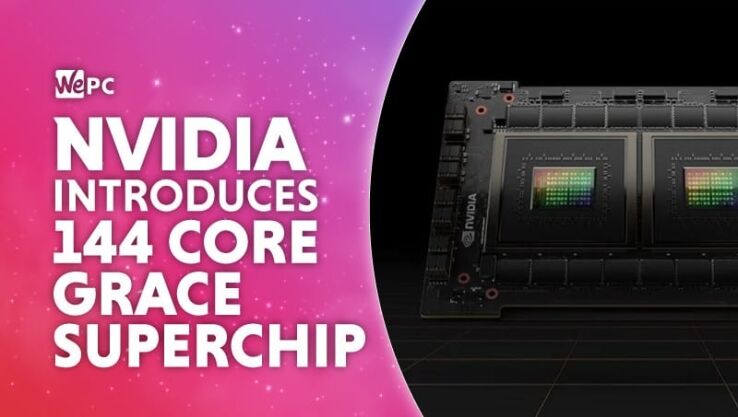Nvidia introduces 144 core Grace Superchip
Nvidia unveils its Grace Superchip, featuring 144 high-performance CPU cores and 1 terabyte/second memory support.

WePC is reader-supported. When you buy through links on our site, we may earn an affiliate commission. Prices subject to change. Learn more
On March 22 Nvidia announced its first Arm Neoverse based data centre CPU designed for higher performance computing and AI calculations. The Nvidia Grace Superchip delivers the best performance and doubles the memory bandwidth, all with unparalleled energy efficiency compared to today’s leading server CPUs.
The Grace Superchip, unlike the Grace Hopper Superchip (Nvidias CPU/GPU all-in-one package), is comprised of two CPU packages connected over the NVLink-C2C interface. This is a new ultra-fast chip-to-chip and die-to-die interconnect that will allow custom chip dies to interconnect to any of Nvidia’s GPUs, CPUs, DPUs, NICs and SOCs.
Nvidia suggests that the new NVLink-C2C with its advanced packaging will deliver up to 25x the energy efficiency, and be 90X more area-efficient than the leading PCIe Gen 5 technology.
Both the Grace Superchip and the Grace Hopper Superchip share the same CPU architecture and the same NVLink-C2C interconnect technology.
Grace Superchip specifications
- High-performance CPU for HPC and cloud computing
- Super chip design with up to 144 Arm v9 CPU cores
- World’s first LPDDR5x with ECC Memory, 1TB/s total bandwidth
- SPECrate®2017_int_base over 740 (estimated)
- 900 GB/s coherent interface, 7X faster than PCIe Gen 5
- 2X the packaging density of DIMM-based solutions
- 2X the performance per watt of today’s leading CPU
- Runs all NVIDIA software stacks and platforms, including NVIDIA RTX, HPC, NVIDIA AI, and NVIDIA Omniverse
The Grace Superchip packs 144 Arm cores into a single CPU socket, offering an estimated performance of 740 on the SPECrate 2017-int-base-benchmark. The brand new AMD EPYC 7773X only scores 440 points in the same benchmark.
Nvidia’s Grace Superchip also offers industry-leading energy efficiency and memory bandwidth with its innovative memory subsystem, which is comprised of LPDDR5X with ECC (error correction code) for the best balance of speed, security and integrity.
LPDDR5X offers one terabyte per second access speed, which is double the standard DDR5 designs, all while consuming much less power. In fact, the whole CPU package consumes just 500 watts at peak.
Based on the latest Arm-v9 data-centre architecture, the Grace Superchip is said to combine the highest single-core performance with Arm’s new generation of vector extensions. This will bring an immediate benefit to many applications.
What’s impressive is that the Grace Superchip is designed to work in tandem with the Grace Hopper Superchip, as both packages run all of Nvidia’s software stacks, including Nvidia RTX, Nvidia HPC, Nvidia AI and Omniverse. The Grace Superchip, along with Nvidia connectX-7 NICs, offer the ability to be integrated into servers as standalone CPU servers or along with the Hopper Superchips for up to eight Hopper based GPUs in a single server.
Use case
The Grace Superchip is exactly what it says on the tin, a super chip. It’s designed for only the highest level of computing – tasks such as HPC, AI, scientific computing, data analytics, and hyper-scale computing applications will tremble in its wake. It’s certainly not designed to be integrated into your fancy RGB gaming rig – although if you manage to do that, let us know how it goes.